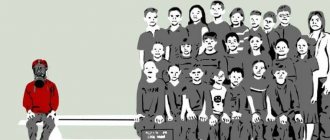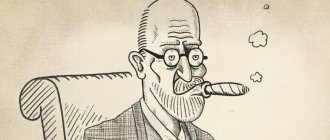January 20, 2021
Hello, dear readers of the KtoNaNovenkogo.ru blog. The term “personality” is used in different scientific paradigms (what is it?): philosophy, sociology, linguistics, psychology. This concept exists even in religion and politics.
We also often use it in everyday life, for example, when talking about someone “an interesting or famous person” and the like. What is this concept? Who can be called that and who cannot? What qualities are needed for this?
Essence and concept
In psychology, the term “personality” is understood as a person who has a set of psychological characteristics that have a direct impact on actions and their significance in society. Each person is individual and therefore always different from the other.
There are also other scientific definitions of personality. For example, his role in society, experience and knowledge. This is a person who bears full responsibility for his life, controls his choices and has a sense of responsibility for his actions.
Thus, personality is a set of habits that have been developed over the years and a person’s preferences, his emotional mood and vitality, sociocultural experience and knowledge accumulated over many years of life. This is a unique set of human traits and characteristics at the psychological and physiological levels. It is also a human archetype that defines everyday behavior and the connection between society and the natural world. In addition, the personality is identified in terms of the manifestation of “behavioral masks” created for different life situations and groups of social interaction.
Personality is a relatively stable system of individual behavior, the core of which is self-esteem, created on the basis of the value judgments of other people and a person’s assessment of his environment.
The concept of personality does not have strict boundaries or frameworks: in everyday life it is understood, for example, as the character of the entire person as a whole
The term “personality” is inextricably linked with two more psychological concepts - individual and individuality. The first is understood as an individual person who has a set of qualities, both innate and acquired. Individuality is a system of characteristics and exclusive traits by which one person can be distinguished from another. It is on this, internal uniqueness, that personal uniqueness and the makeup of the human psyche depend.
Despite the similarity of definitions, they cannot be identified or equated with each other, because both terms describe individual aspects of human life. At the same time, it would also be wrong to excessively distance the concepts from each other. After all, each person is multifaceted, it is impossible to consider him exclusively from one side, like the visible side of the Moon.
Individuality in psychology
In this regard, the concept is related to the term “individual” - a representative of a community of people.
In this understanding of psychologists, the differences between people consist of physiological and mental characteristics. Among the first: height, hair color, eyes. Secondly, there is a set of abilities, a type of temperament, and a level of emotionality. The formation of individuality always takes place differently for everyone. A person becomes isolated on a personal level and goes through a process of self-determination. As a result, he feels unique and unrepeatable.
An individual personality is always original, takes an active social and creative position, and manifests itself in a large number of life forms. This often occurs during the process of socialization. First, a person learns the norms and rules of behavior accepted in society, and then forms an individual interpretation of diverse patterns of behavior and communication.
A characteristic reflection of the concept of individuality has become such epithets as creativity, originality, brightness, talent. As for personality, words such as fortitude, energy, determination, and independence are most often used here.
Psychologists often equate the concept of individuality with personality. This applies to interpretation options that are taken in a broad sense and mean all the distinctive features that are characteristic only of a particular person. But more often, scientists attribute individuality to personal properties.
Charismatic personality - what is it like?
Personality structure
Both the concept itself and the structure of personality have raised questions and disputes among researchers and scientists over many years of the development of psychological science. Some psychologists are convinced that the term cannot be structurized or rationalized at all. At the same time, other specialists do not tire of searching for and discovering new theories of personality structure. However, today there are some clearly defined parameters that make it possible to understand the structure of personality. There are several such systems. Depending on objective and subjective social properties, personal structure is based on such approaches as:
activity, culture, memory, value orientations, culture, roles and statuses
Biological and social structures of personality have 4 levels:
1. Lower - a substructure that combines age and gender properties of the psyche, innate characteristics of the nervous system, aspects of temperament.
2. The second is individual manifestations of memory and perception, thinking and abilities, sensations. These characteristics depend both on innate factors and on acquired experience - training, development and improvement.
3. The third is social experience based on knowledge and skills, habits and abilities.
4. The highest level represents the orientation of the individual. It consists of drives and desires, inclinations and views, interests and ideals, beliefs and worldview.
People differ significantly from each other: each substructure of a particular personality has differences in beliefs and interests, experience and knowledge, abilities and skills, character and temperament. That is why it can be difficult to understand another person by the example of oneself; it is not easy to understand contradictions and discrepancies in opinions, the nature of conflicts between people. For a deeper understanding of yourself and others, you cannot do without certain knowledge and natural observation.
Key components of personality: temperament, character, abilities, emotions and will, motives and needs, orientation
Basic personality types
One of the most popular personality typologies was developed by Swiss analytical psychologist Carl Gustav Jung. In his work as a practicing psychologist, Jung distinguishes two main personality types: extroverts and introverts. The typology differs depending on what a person is more focused on during his life: on external objects or on internal experiences. One can often mistakenly classify oneself as the opposite type due to the existing special tendency, which aims to compensate for one-sided actions.
One should also take into account the fact that each person contains the qualities of both an extrovert and an introvert, a certain combination of which represents a specific personality type. “Life is determined by consciousness” - this is exactly what can be said in the case of an extroverted personality type. “Consciousness determines life” is a more relevant principle for introverts.
It would be logical to strive to balance both types, but in real life this does not happen: there is always a certain “skew” in worldview and self-identification. As a result, a certain type is distinguished according to the method of predominance of one or another mechanism of interaction with the outside world.
Diagnostics
Individuality in psychology is a personality trait that is determined through methodological research. As a rule, standard and approved research methods are used.
They include:
- Personal principles. The essence of this method is that the specialist must carefully study the features not of isolated perception, thinking, memory, but the features of thinking and perception of the human world around him. That is, the method consists in revealing the relationship between psychological processes and what kind of personality the subject is.
- The principle of unity not only of human activity, but also of his consciousness. The point is that consciousness and activity are connected in personality. The assessment of individuality in this case is carried out by determining the interrelated functions and processes of the mental type.
- Principles of determinism. For this method, external factors that affect the personality are refracted through the personality itself. Moreover, the so-called internal is the determinant of the external.
These methods are the main diagnostic measures that are used in the process of psychological research. According to such events, a specialist can determine the level of individual integrity.
However, it is worth noting that there is no single acceptable scheme for conducting psychological diagnostics of individuality. There are only recommended principles that are considered the most accurate. We are talking about the methods of G.D. Pir'ova and B.G. Ananyeva.
Individuality is considered as one of the aspects of a person’s personality, and accordingly it is very difficult to assess the dissimilarity of a particular person. Today there are no universal criteria that can determine individuality.
This is because there are a huge number of cultural and scientific systems. They all differ in different ways of assessing actions, as well as the actions of people.
That is, recommended methods can be used for diagnosis, but the result, which can be understood as a norm or deviation, depends on many factors, including even the specific country or region of the study.
Personality qualities
Personality traits in psychology are understood as a unique set of traits and characteristics that are inherent to a person. They are purely personal in nature and express aspects of character, behavioral patterns in society or the surrounding world.
Personal qualities are characterized by dynamism and stability. They influence all aspects of human life, be it the choice of clothes for going out or career preferences and ambitions in professional activities.
Personality traits are classified into several types, for example:
Socio-psychological. Basic and secondary properties, a set of traits and features in the structure of an individual.
Strong-willed. For example, purposefulness, independence, determination, endurance.
Moral. These properties are adjusted by life under the influence of a combination of factors: position in the family; the influence of an educational institution or a yard company; relations in society; individual life experience, etc. Each aspect operates according to specific moral rules. They form the individual’s attitude towards himself and his environment. Based on the values inherent in the inner world, moral qualities are classified into humanistic, nationalistic, racial, religious-fanatical.
Professional, for example:
verbality - language skills, excellent connections between words and concepts love and mastery of numbers - the ability to perform standard arithmetic operations with maximum accuracy and efficiency correction of numbers, three-dimensional understanding of objects detailing of objects and graphics motor coordination by the movement of limbs and eyes, coordination of signals dexterity and color perception general intelligence - a predisposition to learn, the ability to draw correct conclusions from assigned tasks
List of characteristics associated with an individual
There is a grouping of certain signs that make it possible to recognize a person, namely:
- a subject who is aware of the totality of his inherent social features;
- a person participating in the socio-cultural life of society;
- a person who has individual characteristics that are manifested in social relationships through communication and work activity;
- the individual is clearly aware of his uniqueness and significance in the social world.
The concept of personality implies that the subject has a clearly expressed own opinion in relation to what is happening around him, that is, there is a worldview. An individual always asks philosophical questions about life, about its own significance in this world. In other words, there are ideas, views and life values that shape a given person.
Personality Traits and Properties
Personality traits or properties refer to human characteristics that denote the deep (internal) characteristics of a particular individual. This applies to both behavior in society and the ability to communicate, as well as a special response to various life situations in the aspect of long-term contacts. The nature of personality traits is both biological (innate) and situational (depending on circumstances).
Personality traits cannot be called physical qualities, social characteristics and titles, or temporary states. Conclusions based on a subjective attitude towards the personality of another person cannot be perceived as personal properties.
Creating a complete and, especially, correct list of personality traits is impossible. Firstly, because it can be infinite, like the number of people on the planet. Secondly, the arbitrary nature of personal properties is always possible. Personality properties from the point of view of visibility are manifested in different ways: through character traits and temperament, interests and habits, developed abilities and style of activity of a particular person.
Temperament, as an important personality trait, describes how a person does something (not what he does). Temperament is determined by the type of higher nervous activity. Depending on its structure, experts distinguish 4 main types of temperament.
Choleric is fast, loud speech, impetuosity of movements, well-expressed facial expressions. A sanguine person has the same traits, but in a less pronounced form. Representatives of these two types are usually optimists in life.
A phlegmatic person needs a long time to respond. Representatives of this type of temperament tolerate monotonous loads well (work on a conveyor belt). It has been established that phlegmatic people in marriage are compatible with all temperaments. A melancholic person can be recognized from a whole crowd of people by the expression of sadness and grief on their face (popularly called the “Pierrot” mask). Melancholic people are eternal and incorrigible pessimists.
With age, in all temperaments, the share of melancholy increases (all people, as they grow older and accumulate life experience, become pessimists)
Temperament is the physiological basis of character. Character is an acquired quality. Character is described through a system of a person’s relationships to 4 structures:
towards oneself (selfishness, egocentrism) towards people (sociability, aggressiveness) towards activities (hard work, laziness) towards things (greed, accuracy)
The core of character is will - the human ability to force oneself to do what is needed in a life situation.
Abilities are those individual psychological characteristics that distinguish one person from another and allow one to quickly and easily perform a certain type of activity. The foundation of abilities is the ratio of hereditary and social. Abilities are formed and developed in the process of human activity. Abilities can be general - thinking, speech, etc. And also special (mathematical, musical, creative, etc.).
Emotions. Why is it so important to understand and know your emotions? The answer is simple: in order to manage them! After all, experiencing emotions and knowing them are not identical concepts. Experiencing emotions does not provide the key to managing them, while knowing them allows you to understand yourself. In order to manage emotions, a person must know how they are structured, as a result of what acts of the soul they appear and continue to exist, despite obvious attempts to hide them.
How is it formed
In psychology, unlike biology, a person is not an isolated separate being, that is, he is considered as a full-fledged member of society.
A person is considered individual when he does not limit himself solely to social norms, but also creates his own personality through a higher level of consciousness. Most often, a person acquires individual traits, however, there are also those parameters that are inherited.
Based on this, it becomes clear why children are very often similar in appearance and behavior to their parents, but do not completely copy their behavior and habits, respectively, creating their own individuality.
Individuality in psychology is dissimilarity. It is formed from several large components. First of all, we are talking, of course, about heredity. In this case, biology and psychology are very intertwined. From a biological point of view, individuality, hereditary, is the external characteristics of a person, as well as the speed of his reaction, and behavioral characteristics.
The second component is more psychological. It determines precisely the person’s environment, based on this, individuality is formed on the basis of the culture in which the person grew up, norms of behavior, ideals and values. Accordingly, dissimilarity is also determined by the place a person occupies in a certain social group.
There is one more component that forms individuality - characteristics of temperament and character itself. This parameter may differ from the hereditary component, as well as the environment. It is temperament and character that can be called the most striking manifestations of a person’s dissimilarity, since this is precisely the main sign of individuality.
These are the main provisions, according to the theory of A.L. Baldwin. He said that a simple individuality is first formed (in childhood), and then it is colored by motivation and cognitive ideas. As a person develops and grows up, individuality becomes more and more multifaceted. Thus, dissimilarity can also be attributed to adaptation.
H. Thome did not agree with Baldwin. He noted that this theory has one drawback. He argued that as a person accumulates a large amount of information, he loses his specific identity. This means that individuality may become more diffuse with age.
Based on this, we can say that the highest peak of individuality, on the contrary, occurs at a young age, when a child is most clearly able to demonstrate his difference, without thinking about the framework and principles of the society in which he is located. This idea was also supported in their works by R. Carson, D. Magnusson and other specialists.
Personality formation
Factors
The psychological development of a person is influenced by hereditary factors, on the one hand, and factors of the physical and social environment, on the other. Mental development, like psychological development, continues throughout a person’s life. The prerequisite for individuality, the root cause for the formation of human originality, is, first of all, the environment where the future personality grows. An important role is played by the associations accumulated by a person in childhood, the model of education that instills moral guidelines, the peculiarities of the family structure and the principles of treating a child.
There is an opinion among psychologists that individuals are born. They become a person. And uniqueness must be defended in the process of life
Genes control human development from birth, just as the lifestyle of the expectant mother affects the fetus. After birth, caring for the child supports his physical life, but at the same time directly affects the mental development of the future personality.
Different stages of a person’s life take into account certain tasks of mental development. Of course, successes occur regularly, but problems often arise. Psychological information is used to find solutions to any child's developmental problems - for example, in terms of language skills or schooling.
There are a number of opinions about which age periods of the individual are most important for the whole life. Psychology of life is the detailed study of human development at each stage of life. Individual development can be viewed through different methodologies and perspectives.
Stages of psychological development of personality, their features and connections with changes in physiology
Childhood. A child's first task is to learn that the world is a safe place and people can be trusted. That is why it is important that what is perceived and viewed by the baby during this period of life is appropriate for his age.
The children's sensory world, due to its immaturity, is still very small. Children under three years of age observe everything at a subconscious level of understanding. By school age, the boundaries of fairy tales and truth begin to be perceived visibly and tangibly.
Adolescence. The most important thing in adolescence is the formation of personality: who I am, how I behave. Today, thanks to technology such as social media, you can even get reactions to your own comments and photos. At the same time, it all becomes surprisingly fragile: feedback can become a problem if she is not resilient enough to accept it.
Youth. This is a period of active self-determination and self-searching. There is often a strong tendency to create idols and negative self-identification in order to strive for a feeling of personal irresistibility. At the end of this stage, people often come to independence and a clear definition of their future life path.
Youth, which lasts approximately from 20 to 25 years, has such characteristic features as the desire to create a family and personal attachments, including intimacy. In first place in importance comes such a feeling as love, a feeling of attachment to a loved one, caring for him.
Maturity is one of the longest periods of personal formation. During this time, a person who has already achieved certain successes in life no longer focuses on his own personality, but on others. He strives to share his accumulated experience, unique knowledge, skills, and finally, simply life wisdom.
Aging. During this phase of development, an active rethinking of one’s actions occurs. Therefore, it is very important for a feeling of happiness to be able to find joyful moments in the past and, of course, maintain physical health as much as possible.
Today, more and more people are able to live to a ripe old age. We need to work to make old age a meaningful and conscious stage of life.
Basic theories of personality research
Sigmund Freud
According to Freud's psychological theory, a person's personality has three main components:
1. Id - “it”, i.e. all aspects inherent in nature and genetics, in particular, due to basic instincts.
2. Ego - a sense of one’s own “I”, which is in constant interaction with the outside world.
3. The superego appears as a kind of judge of activities and thoughts. Its functions are carried out by conscience, introspection and formed ideals.
Carl Gustav Jung
Jung in his medical practice was guided by an individual approach to each patient. Therefore, he began his work by establishing the patient’s character traits, the peculiarities of his psyche. He achieved this difficult goal with the help of a unique system - a typology of personalities. She served him as a map, helping to identify the specifics of the individual. Understand the prevailing psychological functions, what is the human relationship to the external world and to the internal world. Thus, Jung identified eight personality types and divided them into two groups - rational and irrational.
He considered the thinking and feeling types to be rational types. People belonging to it, in making decisions and making judgments, are guided by pre-formed views and beliefs, and perceive the world through the prism of attitudes of consciousness.
The scientist designated the sensing and the intuitive as irrational. People of these types are less guided by reason; they react to stimuli the way they react, without trying to squeeze into the framework of their own or others’ views. Direct experiences are important to them.
William James
The American pragmatic psychologist argued that man has continuous thinking and selective consciousness, emphasizing that life is the sum of various habits. He analyzed personality from three sides - the constituent elements (physical or material, social and spiritual), feelings and emotions (self-esteem), as well as actions caused by self-preservation and self-care.
James' personality formula states that cognition consists equally of attitude and behavior.
Alfred Adler
According to the principles of individual psychology of another scientist, an individual’s lifestyle is demonstrated through attitudes and behavior. At the same time, it is necessarily formed under the influence of society. According to Adler, personality has a single structure, and the fundamental factor in its development is the natural desire for superiority. Therefore, a person is divided into four main subtypes: socially useful, avoidant, receiving, managing.
Roberto Assagioli
In accordance with the psychosynthesis of this specialist, there are 8 zones in the basic structure of the human psyche. The lower unconscious begins the pyramid of substructures, and the subpersonality completes it. The meaning of the development of the psyche is to increase its unity.
Biological approach
The so-called type theory puts a key emphasis on the structure of the human body. For example, according to Kretschmer’s constitutional typology there is leptosomatic, alectic, picnic, dysplastic. And Sheldon classified personalities according to endo-, ecto- and mesomophic physiques.
Eduard Spranger
Another concept describes the human personality according to the form of knowledge of the world and spiritual values. This could be a theorist, economist, esthete, politician, and so on.
Gordon Allport
The opinion is based on the uniqueness of each individual in specific traits. The author of the theory believed that what is “own” in a person’s inner world is his unique distinguishing feature.
Kurt Lewin
The source of the driving forces of personality, according to Lewin, is hidden in the tandem of a person with a situation and is determined by his attitude to certain circumstances.
Phenomenological and humanistic theories
The main principle is a positive beginning in every person, the desire and realization of personal potential to the maximum. For example, one of the proponents of this approach, A. Maslow, put the human need for self-actualization in the first place.
Erich Fromm
Its adherents consider self-expression and manifestation of personal individuality to be the leading position in this concept.
Victor Frankl
The key points are freedom, responsibility, the meaning of life.
* * *
To sum up, we can confidently say that a person’s personality, both in the skeptical science of psychology and in the versatile practice of life, is multifaceted and unique, like the exclusive pattern of a tiny snowflake under a microscope. In our changing and far from ideal world, it is very important to preserve our own unique features and originality, values and priorities.
Whatever the external circumstances, it is important to remember one main truth: I am a person, the whole world, the Universe, the endless Cosmos. And a real person should not adapt to the changing world, as the famous song says, or try to imitate someone, even if this person is a real star.
To achieve success in any aspect of life, it is important to be aware of your desires and aspirations, understand yourself and adequately assess your abilities. No one else can take the place in the sun intended for a specific person. Because every individual is one of a kind. And therefore unique.











